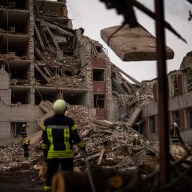ST. JOHN’S, N.L. – Spouses hugged and kissed each other before Cougar Flight 151 departed Monday for the White Rose offshore oilfield, the first helicopter to carry Newfoundland oil workers to their jobs since a chopper crash two months ago killed 17 of their colleagues.
The flight marked the resumption of Cougar Helicopter service following the March 12 crash of Flight 491, a tragedy that continues to haunt the province’s offshore community, said company general manager Rick Burt.
“On that day we experienced a loss that we will carry with us throughout our lives,” Burt said in a video message on Cougar’s website.
“We continue to pray for the families and friends of those lost that day and their pain we cannot begin to understand.”
Thirteen passengers wearing orange survival suits walked in single file on the tarmac before boarding the helicopter Monday morning. The chopper flew them to the GSF Grand Banks, a semi-submersible drill rig moored about 350 kilometres east of St. John’s.
But, Cougar’s entire flight schedule did not go as planned. Four passengers were bumped because of weight restrictions – “not an uncommon occurrence,” said Cougar Helicopters spokeswoman Cathy Dornan.
Heavy fog at Hibernia and Terra Nova, the province’s two other offshore oilfields, forced the cancellation of three other scheduled flights. Those bumped were ferried to work along with co-workers on board offshore supply vessels, their sole mode of transportation since the crash.
Several workers declined comment on their way in to the Cougar Helicopter base.
“Too early in the morning,” one man quipped.
Some workers have expressed worries about flying again, according to a question-and-answer memo compiled by the oil companies that operate the offshore platforms.
Sheldon Peddle, the president of the union that represents about 700 workers at Hibernia and Terra Nova, has said he and others are not comfortable about Cougar’s plans to resume flights.
But the decision to restart passenger service was made after a “comprehensive review” of Cougar’s operations that included oil companies and industry regulators, as well as test flights, Burt said.
“We affirm our commitment to safety and industry best practices,” he said.
Cougar has directed its pilots to fly at a maximum altitude of 2,134 metres – 610 metres lower than the cruising altitude of the Sikorsky 92-A that crashed – after workers questioned why Flight 491 was flying so high.
Husky Energy general operations manager Trevor Pritchard said last week that the lower altitude would allow pilots to ditch more safely should an emergency arise.
But Pritchard said he could not conclude whether that meant Cougar Flight 491 was flying at an unsafe height.
The Transportation Safety Board is still investigating the crash, but it has said that titanium mounting studs that attach an oil filter bowl assembly to the main gearbox broke during the flight. Those have since been replaced with steel.
The federal agency has said the pilots indicated there was a problem with the main gearbox oil pressure before the crash.
The board has said it remains unclear precisely what caused the crash, but less than 10 minutes after the oil pressure loss, the chopper slammed at high speed into the Atlantic, about 65 kilometres southeast of St. John’s.
Robert Decker, the sole survivor, escaped through the helicopter’s window.
The Canada-Newfoundland and Labrador Offshore Petroleum Board, which regulates the offshore oil industry, has launched a public inquiry to examine “worker safety.” It is still drafting the probe’s terms of reference.















